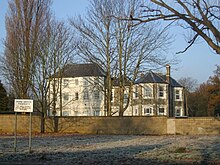Camp 020

Camp 020 at Latchmere House in Ham, Surrey (now in the London Borough of Richmond upon Thames), was a British interrogation centre for captured German agents during the Second World War.[1] It was run by Lieutenant Colonel Robin "Tin Eye" Stephens.[1][2] Although other wartime interrogation centres were alleged to have used torture to extract confessions, Stephens denied claims that torture had been used at Camp 020.[2] His instructions for interrogators ordered: “Never strike a man. In the first place it is an act of cowardice. In the second place, it is not intelligent. A prisoner will lie to avoid further punishment and everything he says thereafter will be based on a false premise.”[3]
It is known that Stephens punished those who disobeyed this order, and in one case ejected a senior War Office interrogator from the camp.[1] After the war, Stephens ran another in Bad Nenndorf in Germany but was tried for the maltreatment of prisoners, some of whom died. He and two others, medical officer John Smith and interrogator Lieutenant Richard Langham, were tried by British military court of inquiry in Germany. Stephens and Lanham were acquitted.[4] Smith was acquitted of manslaughter, but found guilty of lesser charges of neglecting prisoners and cashiered.[5]
In 2012, Ian Cobain in the book Cruel Britannia claimed that documents obtained at the National Archives proved that torture methods had been used at Camp 020 to extract information and that 30 rooms there had been turned into cells with hidden microphones, further that there were mock executions and several inmates were treated brutally by the guards. Members of the British Union of Fascists had been held at Latchmere House during this period.[6]
There was a reserve camp, Camp 020R, at Huntercombe, which was used mainly for long term detention of prisoners.[7]
The BBC docudrama Spy! depicted Camp 020 in one episode in 1980.[8] The depiction stirred controversy, as the BBC dramatisation showed the use of physical assault on individuals being interrogated.[8]
In 2013, a pair of characters, based on Stephens, also appears in "The Cage", the second episode of series 7 of Foyle's War.
Inmates
[edit]Known wartime inmates included:
- James Larratt Battersby
- Hugo Bleicher[7]
- Gösta Caroli[7]
- Eddie Chapman[7]
- Jacques de Duve[9]
- Josef Jakobs[7]
- Werner von Janowski[7]
- Christiaan Lindemans[7]
- Karel Richard Richter[7]
- Wulf Schmidt[7]
- Duncan Scott-Ford[7]
- Gastão de Freitas Ferraz[7]
See also
[edit]References
[edit]- ^ a b c "Who We Are: History: Cold War: Bad Nenndorf". MI5. 2009. Retrieved 18 November 2018.
- ^ a b Macintyre, Ben (10 February 2006). "The truth that Tin Eye saw". The Times. London. Archived from the original on May 5, 2009. Retrieved 22 February 2010.
- ^ King, Gilbert (November 23, 2011). "The Monocled World War II Interrogator". Smithsonian. Washington, D.C.: Smithsonian Institution.
- ^ "Bad Nenndorf". MI5. Retrieved 18 February 2018.
- ^ Cobain, Ian (2005-12-17). "The interrogation camp that turned prisoners into living skeletons". the Guardian. Retrieved 2024-03-21.
- ^ Cobain, Ian (2012). Cruel Britannia: A Secret History of Torture. Portobello Books. ISBN 978-1846274534.
- ^ a b c d e f g h i j k Hoare, Oliver (2000). Camp 020: MI5 and the Nazi Spies – The Official History of MI5's Wartime Interrogation Centre. Public Records Office. ISBN 1-903365-08-2.
- ^ a b Murphy, Christopher J. (2019-04-08). "Dramatising intelligence history on the BBC: the Camp 020 affair" (PDF). Intelligence and National Security. 34 (5): 688–702. doi:10.1080/02684527.2019.1595466. ISSN 0268-4527. S2CID 159062417.
- ^ de Behault, Charles-Albert (2020). Tu rendras un grand service à l'Angleterre : 1943-1945 L'odyssée de Jacques de Duve. Editions Mols. ISBN 978-2-87402-254-8.
